BLOG, or DIE. Author Bio
Tuesday, 26 April 2011
Dining with the Swamp Fox
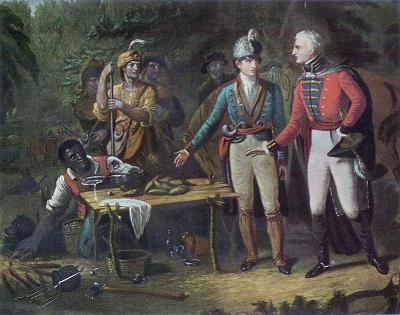 I received a lot of interesting feedback from my April 19th post dealing with the painting The Prayer at Valley Forge. Today I would like to examine another piece of artwork that has been the subject of debate.
I received a lot of interesting feedback from my April 19th post dealing with the painting The Prayer at Valley Forge. Today I would like to examine another piece of artwork that has been the subject of debate.
This oil on canvas painting titled General Marion Inviting a British Officer to Share His Meal, by South Carolina artist John Blake White, was presented to the U.S. Senate in 1899. According to a senate publication on the piece:
The artist has painted the red-coated British officer and Marion at right center, with a horse. Marion wears a plumed shako. His soldiers present an amusingly motley crew. Of special interest is the African American man behind the table, holding a small pan and, with his right hand, roasting sweet potatoes in the fire. This figure was likely meant to represent Marion’s slave or manservant, although Samuel Weaver’s pension application maintains that Weaver himself, a white soldier, was the one who cooked the meal. The makeshift table has a number of sweet potatoes on it, and Marion gestures toward them.
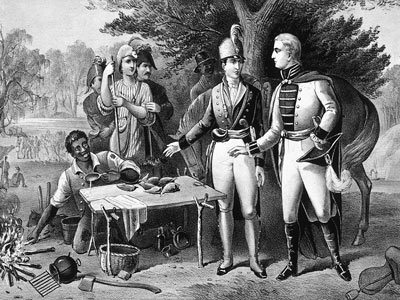 White’s portrayal was made into this mezzotint print by John Sartain in 1840 for the Apollo Association for the Promotion of the Fine Arts in the United States. The image was later used on the 1861 Confederate ($5) banknotes that were issued by South Carolina. An exhibition catalogue dramatically described the story behind the image this way:
White’s portrayal was made into this mezzotint print by John Sartain in 1840 for the Apollo Association for the Promotion of the Fine Arts in the United States. The image was later used on the 1861 Confederate ($5) banknotes that were issued by South Carolina. An exhibition catalogue dramatically described the story behind the image this way:
After the business had been arranged, Marion invited the visitor to take dinner with him. The moment chosen by the Artist is when they approach the table, which was composed of pieces of bark, bearing a dinner of sweet potatoes. The expression of surprise on the countenances of the stranger and Marion’s men is finely expressed. The scenery is said to be perfectly characteristic of a South Carolina swamp; and, altogether, it may safely be pronounced one of the best pictures of American history ever produced in this country.
This version became the accepted interpretation of the piece until James P. Truluck, a descendant of the alleged British Officer, accused it of being revisionist history. According to Truluck, the depicted roles of Marion as host and the Englishman as guest were actually reversed. According to Truluck (in an 1989 article in Carologue, the journal of the South Carolina Historical Society), Captain John Brockington, Jr.—a landowner, slave-owner, and Tory sympathizer, who had fought against the “Swamp Fox”—was the legendary officer depicted in the piece. He added that his ancestor had been among the Tories that were banned to Nova Scotia after Continental forces assumed control of South Carolina.
In an effort to regain his land and reputation, Brockington returned to the colonies to refute his Loyalists ways and repay any claims that were made against him. After receiving a pardon, he and his slaves headed home and traveled through the swamps to avoid confrontation. It was while preparing their own camp meal that Truluck states Marion found them (resulting in the painted scene). He added that Brockington had extended an invitation to the “Swamp Fox” to join them - and joked that Marion had done the same.

Friday, 22 April 2011
Ben in the 'Burg
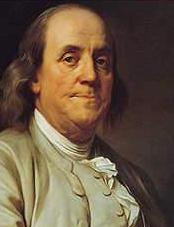 The Senator John Heinz History Center in Pittsburgh has just opened a wonderful exhibition titled “Ben Franklin, In Search of a Better World”. The 8,000 square-foot exhibit, which features more than 150 artifacts and nearly 30 hands-on interactive activities, will immerse visitors in Franklin's world and provide new insights on many previously unknown aspects of his amazing life, including his connections to Western Pennsylvania. A special section of the exhibit is dedicated to Franklin's ties to Western Pennsylvania. In 1755, Franklin obtained nearly 150 wagons from farmers throughout Pennsylvania that were used during General Edward Braddock's failed attempt to capture Fort Duquesne from the French. The incident was later referred to by Franklin in his autobiography as "the wagon affair."
The Senator John Heinz History Center in Pittsburgh has just opened a wonderful exhibition titled “Ben Franklin, In Search of a Better World”. The 8,000 square-foot exhibit, which features more than 150 artifacts and nearly 30 hands-on interactive activities, will immerse visitors in Franklin's world and provide new insights on many previously unknown aspects of his amazing life, including his connections to Western Pennsylvania. A special section of the exhibit is dedicated to Franklin's ties to Western Pennsylvania. In 1755, Franklin obtained nearly 150 wagons from farmers throughout Pennsylvania that were used during General Edward Braddock's failed attempt to capture Fort Duquesne from the French. The incident was later referred to by Franklin in his autobiography as "the wagon affair."
On display: One of the first books Franklin printed, "Religion of Nature Delineated," an original copy of the 1787 U.S. Constitution, a signed copy of Franklin's Bible, rarely displayed personal objects such as books, a chess set, china, furniture and coins, Franklin's inventions, including bifocals, the Franklin stove, the armonica (glass musical instrument), and microscope, as well as a display which highlights pop culture references related to Franklin, featuring everything from Franklin advertising campaigns, mugs, pins, masks, and even bobbleheads. For more information visit the exhibition webpage. You can also view a video of the artifacts courtesy of WDUQ.
I hope to visit the exhibit in person this weekend and provide a detailed photo-essay and synopsis of the experience upon my return.

Thursday, 21 April 2011
An exceptional film. A tremendous loss.
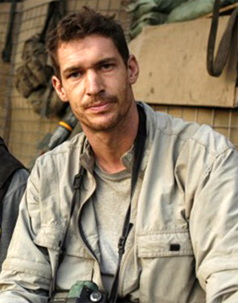 It’s just after midnight on Wednesday and I really should be in bed. My day job with the U.S. Marshals Service demands a 4:30 am wake-up call followed by a 1.5 hour train commute. Any responsible adult would have hit the sack hours ago, but what the hell…I’ve already accepted the fact that tomorrow I probably won’t be worth a damn anyway. Why am I still awake? I just finished watching what may be the best short film that I have ever seen.
It’s just after midnight on Wednesday and I really should be in bed. My day job with the U.S. Marshals Service demands a 4:30 am wake-up call followed by a 1.5 hour train commute. Any responsible adult would have hit the sack hours ago, but what the hell…I’ve already accepted the fact that tomorrow I probably won’t be worth a damn anyway. Why am I still awake? I just finished watching what may be the best short film that I have ever seen.
It’s called Restrepo and it tells the incredible life and death story of a forward-deployed U.S. platoon in Afghanistan, operating in the Korengal Valley. It’s raw, visceral, and makes you proud to be from a country where boys like this are raised. It was released by National Geographic Entertainment, nominated for an Oscar (Best Documentary) and won the 2010 Sundance Film Festival Grand Jury Prize. Film critic Peter Travers outlined this remarkable movie's plotline for his review in Rolling Stone Magazine:
Here's a documentary that embeds you deep into the war in Afghanistan. Filmmakers Tim Hetherington and Sebastian Junger follow a platoon of U.S. soldiers, the Second Platoon, Battle Company, 173rd Airborne Brigade, during their 14-month deployment to the Korengal Valley. The troops are shaken when their beloved medic, Juan "Doc" Restrepo, is killed in action. That’s when Capt. Dan Kearney pulls out all the stops to allay fears even in the Taliban war zone. Naming their base after Restrepo, these soldiers are seen dealing with death on a daily basis. The filmmakers offer no commentary. We watch. And what we see is explosive, deeply moving and impossible to shake.
As a documentary producer, I am ashamed to say that I only learned of this film today after reading a report that its director/co-producer was killed while covering the fighting in Misratah, Libya. Another photojournalist was killed in the attack and several others on their crew were badly wounded. This seems to be the same sad story that we have heard all too often in recent years…some son of a bitch in a towel with an RPG pops out of a hole and takes a potshot at the good guys. I guess these insurgents and rebels think that the media makes just as good a target as soldiers do. It speaks to their cowardice as attacks on the press have ramped up all over that part of the world. I guess if you can’t hit the guys with guns, aim at the guys with cameras. Bastards.
The brilliant mind behind this film is, or was, Tim Hetherington, a highly respected British journalist and filmmaker. He was an experienced, imbedded-correspondent with an amazing talent for stripping away all the political bullshit to reveal the tragic simplicity of war. I read several interviews with him this evening and one statement in particular jumped out at me. He said, “I’ve come to realize the war machine is, in fact, very human. Take a group of young men, train them together, put them on the side of a mountain and they will kill and be killed for each other.” That sums it up.
As someone living in VA and working in DC, I know soldiers that were deployed to Afghanistan, as well as some contractors that are there now. THESE guys are the real heroes. They volunteer to do the most dangerous jobs – in the most dangerous places. And they do it to protect us and improve the lives of uncivilized people who hate them. The debt we owe them can never be paid in full.
Afghanistan is a mess. It is an undeveloped bastion of ‘suck’ on a good day, so I can’t even begin to imagine what daily firefights and mortar attacks does for the place. Yet here we have a team of documentary filmmakers, right in the thick of it, getting incredible footage while ducking bullets and tracers. The result is an intimate portrait, plucked from the chaos of combat that cannot be duplicated any other way.
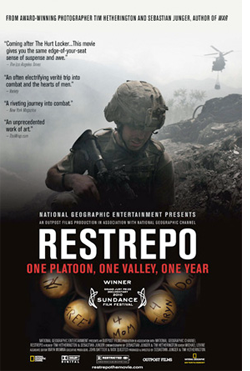 Unlike most films today, Restrepo doesn’t have any fancy graphics or special effects. The instrumental song that plays the audience in and out of the film was performed live by a soldier with a dirty acoustic guitar. Some of the footage is gritty and blurry and so freaking real you get a knot in the pit of your stomach as you watch it. The stress level that these soldiers experienced is shared beyond the screen as you too find yourself anticipating the danger that lies around the bend. Several of the troops are shot and killed during the film, reinforcing the fact that this is reality-TV for real.
Unlike most films today, Restrepo doesn’t have any fancy graphics or special effects. The instrumental song that plays the audience in and out of the film was performed live by a soldier with a dirty acoustic guitar. Some of the footage is gritty and blurry and so freaking real you get a knot in the pit of your stomach as you watch it. The stress level that these soldiers experienced is shared beyond the screen as you too find yourself anticipating the danger that lies around the bend. Several of the troops are shot and killed during the film, reinforcing the fact that this is reality-TV for real.
I never met Mr. Hetherington, nor was I aware of his contributions to the world until today. Unfortunately it is only after his untimely death that I am now discovering an amazing body of work from print and television - to film and photo.
Our documentary projects at Right Stripe Media are historic and take place on Civil War battlefields and Wild West sites hundreds of years after the fighting ended. If we want to show the carnage, we recreate battles and gunfights with re-enactors and pyrotechnics. The only danger we face on one of our shoots is sunburn or maybe eye strain from spending too much time at the computer. So it’s a very sincere gesture when I say that I want to tip my hat to all of these battlefield filmmakers, especially Tim Hetherington for having the vision, and the balls, to create movies like Restrepo.
Real war-journalists, the “Hetheringtons” of the world, risk life and limb to visually preserve and present history as it unfolds. Our production group’s mantra is that we create living history. Tim and his comrades capture it. He will be missed by many, now including me. And although I may never produce a documentary with the soul of Restrepo, I am inspired to try, now more than ever.
ADDED 4/21: Our friend Jared Frederick over at History Matters had the pleasure of meeting and speaking with Tim Hetherington a few months ago. He posted a wonderful blog piece on February 22nd detailing the experience.

Wednesday, 20 April 2011
Homeward Bound
My posts will be far and few over the next week as I prepare for my upcoming lecture and screening at the CarnegieCarnegie Library and Music Hall’s 6th Annual Civil War Weekend. You may recall that we held our ‘northern’ premiere of “The Angel of Marye’s Heights” documentary at this venue back in November. It was an absolute thrill for me as Pittsburgh PA is my hometown and I was able to share the experience with plenty of friends and family. This event looks to be even better (see schedule) and I hope to become a recurring participant. On Saturday April 30th, I will be giving a lecture titled “Gallant Boys of the 123rd,” which presents the experiences of the PA Volunteers at the Battle of Fredericksburg. That will be followed by a screening of “The Angel” w/ a producer Q&A. Once that is finished I get to do it all over again. In addition to our traveling exhibit that features a kiosk, props and handouts, I will be joined by Pittsburgh author Scott Lang who wrote The Forgotten Charge: The 123rd Pennsylvania at Marye's Heights, Fredericksburg, Virginia. Scott has a wonderful collection of 123rd relics that he will be displaying at an adjacent table. I will have copies of “The Angel” DVD for sale ($12) as well as Will White’s soundtrack CD ($10). I’ll also have photos and video to share upon my return. I will be hosting 2 film screenings and a book signing at the Manassas Museum on May 15th (details to come).

Tuesday, 19 April 2011
Continuing with our recurring theme on the myths of the Founding Fathers…
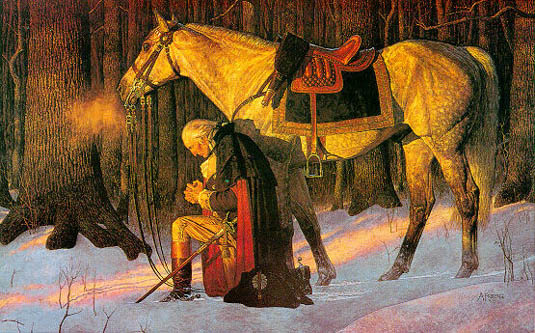
You may be familiar with the painting above titled “The Prayer at Valley Forge.” This controversial image was painted by artist Arnold Friberg to celebrate our country's Bicentennial in 1976. It is one of several notable artworks depicting General George Washington in the act of prayer while at Valley Forge. In the Congressional Prayer Room at the Capitol there is a stained-glass window also depicting the general on his knees, praying in the snow at the same location. Similar images appeared on a 2-cent stamp in 1928 commemorating the 150th anniversary of the Valley Forge encampment, and on the 13-cent Christmas stamp in 1977. Although it is very likely that Washington prayed while on campaign, this particular (and repetitive) depiction of him (at Valley Forge) stems from a highly-contested story which is believed and refuted by many.
Even a casual Google search on this event will reveal all kinds of amateur/unsanctioned web-pages where religious organizations or individuals have assembled various incarnations of this event. Some even include quotes, which were apparently “re-discovered” in the 20th-century. These fallacies appear to fulfill a need to validate that America was founded as a Christian nation. One page even states that: “His ‘Prayer at Valley Forge’ was a well known fact until the latter half of the 20th century, when the United States, in the process of replacing Christianity with Secular Humanism, allowed itself to believe that the prayer was merely sentimental legend.” Of course there is no source to support this claim.
It is the need to ‘prove’ or ‘disprove’ this event that fascinates me. For a more scholarly (and perhaps objective) interpretation of this event, I looked to renowned Washington historian Edward G. Lengel. Professor Lengel is the editor in chief of the prestigious Papers of George Washington project at the University of Virginia. He has also written two excellent books on the man. These include Inventing George Washington: America's Founder, in Myth and Memory and my personal favorite, General George Washington: A Military Life. He is without an agenda and according to him; there is less to the story.
I’m not the only one who considers Dr. Lengel an expert. In an article written for the Boston Globe titled “The many myths of George Washington,” contributing writer Michael Kenney challenges the genesis of this depiction of a praying patriot by quoting the author. He writes:
Despite the depictions [of Washington praying at Valley Forge], it is a story with “dubious origins,’’ writes Edward G. Lengel in “Inventing George Washington,’’ his account of the myths and legends that sprang up to breathe life into a symbolic figure. Like the kneeling-in-the-snow tale, the cherry-tree yarn first appeared in “Parson’’ Mason Weems’s biography published in 1800 — a temporal immediacy that did not, however, turn the anecdotes into facts. Weems, Lengel explains, was “lazy’’ about research and facts, allowing his imitators to produce “an increasingly outrageous array of myth, legend, and outright fraud in the name of recovering Washington’s humanity.’’ Lengel’s claims intentionally counter the oft-misquoted account that “supports” this moment of Washington knelt in prayer. It was apparently recorded in the “Diary and Remembrances” of Reverend Nathaniel Randolph Snowden who recalled:
…"Do you see that woods, & that plain?" It was about a quarter of a mile off from the place we were riding, as it happened. "There," said he, "laid the army of Washington. It was a most distressing time of ye war, and all were for giving up the Ship but that great and good man. In that woods pointing to a close in view, I heard a plaintive sound as, of a man at prayer. I tied my horse to a sapling & went quietly into the woods & to my astonishment I saw the great George Washington on his knees alone, with his sword on one side and his cocked hat on the other. He was at Prayer to the God of the Armies, beseeching to interpose with his Divine aid, as it was ye Crisis, & the cause of the country, of humanity & of the world. Such a prayer I never heard from the lips of man. I left him alone praying. I went home & told my wife, I saw a sight and heard today what I never saw or heard before, and just related to her what I had seen & heard & observed. We never thought a man c'd be a soldier & a Christian, but if there is one in the world, it is Washington. She also was astonished. We thought it was the cause of God, & America could prevail." As wonderful as that sounds, it is obviously written with a flair for the dramatic. Even as far back as 1945, Washington curators and historians have questioned the validity of this story. In an article written for the Valley Forge Historical Society’s publication The Picket Post titled “Prayer of Valley Forge May Be Legend or Tradition or a Fact, Yet It Remains Symbol of Faith” author Gilbert Starling Jones states:
Few incidents in the life and actions of Washington, while he was Commander-in-Chief of the armed forces battling for The Independence of the American Colonies have been more controversial or more often related than the "Prayer of Valley Forge." Did he, or did he not, pray at the Winter Encampment is quite as familiar to readers of historical tomes touching the American Revolution as "to be or not to be" is to the average man who may or may not know further about the Bard of Avon. No attempt is made, presently, by this compiler to establish documentary proof that Washington was seen at Valley Forge in supplication upon the Divine Will in the need of Almighty direction. The purpose, more especially, is to direct the readers' thoughts into a channel whereby to essay the relations of an episode, be it traditional or fact, that may furnish a key to the inner depths of the character of the great and lonely man at Valley Forge — a character so needed in today's world. It appears that even the society charged with the preservation and presentation of Valley Forge history openly admitted the questionable accuracy of the story. Since then this particular image of Washington has grown to become as much a cherished memory as a form of propaganda. This is no doubt due to the governmental-endorsement implied by the stained glass and stamps – and the convenience it levies to religious groups. In addition to print and paintings a bogus guidebook was published that directed Valley Forge tourists to the: “exact spot upon which the General kneeled in prayer.” This is perhaps the falsest claim of all.
The question in my mind is not if George Washington did or didn’t pray at Valley Forge as presented in the above descriptions. The questions are why is this particular event so significant? Why this moment – at this location? And why did it become such a contested image?
Historically, I’m with Dr. Lengel. I don’t necessarily believe that this painting depicts an actual event. I also don’t fancy the fact that religious organizations claim absolute validity over it in support of their political agenda. I do however, believe what this image represents. Valley Forge was one of the lowest points for the Continental Army. It is during the most trying of times that our faith most often prevails. Accurate or not, General Washington sets an example we all could follow.

Newer | Latest | Older
 I received a lot of interesting feedback from my April 19th post dealing with the painting The Prayer at Valley Forge. Today I would like to examine another piece of artwork that has been the subject of debate.
I received a lot of interesting feedback from my April 19th post dealing with the painting The Prayer at Valley Forge. Today I would like to examine another piece of artwork that has been the subject of debate.  White’s portrayal was made into this mezzotint print by John Sartain in 1840 for the Apollo Association for the Promotion of the Fine Arts in the United States. The image was later used on the 1861 Confederate ($5) banknotes that were issued by South Carolina. An exhibition catalogue dramatically described the story behind the image this way:
White’s portrayal was made into this mezzotint print by John Sartain in 1840 for the Apollo Association for the Promotion of the Fine Arts in the United States. The image was later used on the 1861 Confederate ($5) banknotes that were issued by South Carolina. An exhibition catalogue dramatically described the story behind the image this way:





 The Senator John Heinz History Center in Pittsburgh has just opened a wonderful exhibition titled “Ben Franklin, In Search of a Better World”. The 8,000 square-foot exhibit, which features more than 150 artifacts and nearly 30 hands-on interactive activities, will immerse visitors in Franklin's world and provide new insights on many previously unknown aspects of his amazing life, including his connections to Western Pennsylvania. A special section of the exhibit is dedicated to Franklin's ties to Western Pennsylvania. In 1755, Franklin obtained nearly 150 wagons from farmers throughout Pennsylvania that were used during General Edward Braddock's failed attempt to capture Fort Duquesne from the French. The incident was later referred to by Franklin in his autobiography as "the wagon affair."
The Senator John Heinz History Center in Pittsburgh has just opened a wonderful exhibition titled “Ben Franklin, In Search of a Better World”. The 8,000 square-foot exhibit, which features more than 150 artifacts and nearly 30 hands-on interactive activities, will immerse visitors in Franklin's world and provide new insights on many previously unknown aspects of his amazing life, including his connections to Western Pennsylvania. A special section of the exhibit is dedicated to Franklin's ties to Western Pennsylvania. In 1755, Franklin obtained nearly 150 wagons from farmers throughout Pennsylvania that were used during General Edward Braddock's failed attempt to capture Fort Duquesne from the French. The incident was later referred to by Franklin in his autobiography as "the wagon affair." It’s just after midnight on Wednesday and I really should be in bed. My day job with the U.S. Marshals Service demands a 4:30 am wake-up call followed by a 1.5 hour train commute. Any responsible adult would have hit the sack hours ago, but what the hell…I’ve already accepted the fact that tomorrow I probably won’t be worth a damn anyway. Why am I still awake? I just finished watching what may be the best short film that I have ever seen.
It’s just after midnight on Wednesday and I really should be in bed. My day job with the U.S. Marshals Service demands a 4:30 am wake-up call followed by a 1.5 hour train commute. Any responsible adult would have hit the sack hours ago, but what the hell…I’ve already accepted the fact that tomorrow I probably won’t be worth a damn anyway. Why am I still awake? I just finished watching what may be the best short film that I have ever seen. Unlike most films today, Restrepo doesn’t have any fancy graphics or special effects. The instrumental song that plays the audience in and out of the film was performed live by a soldier with a dirty acoustic guitar. Some of the footage is gritty and blurry and so freaking real you get a knot in the pit of your stomach as you watch it. The stress level that these soldiers experienced is shared beyond the screen as you too find yourself anticipating the danger that lies around the bend. Several of the troops are shot and killed during the film, reinforcing the fact that this is reality-TV for real.
Unlike most films today, Restrepo doesn’t have any fancy graphics or special effects. The instrumental song that plays the audience in and out of the film was performed live by a soldier with a dirty acoustic guitar. Some of the footage is gritty and blurry and so freaking real you get a knot in the pit of your stomach as you watch it. The stress level that these soldiers experienced is shared beyond the screen as you too find yourself anticipating the danger that lies around the bend. Several of the troops are shot and killed during the film, reinforcing the fact that this is reality-TV for real. 